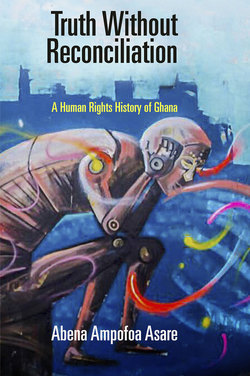Читать книгу Truth Without Reconciliation - Abena Ampofoa Asare - Страница 8
На сайте Литреса книга снята с продажи.
ОглавлениеPREFACE
In 2007, when I located the records of Ghana’s National Reconciliation Commission (NRC) at the University of Ghana’s Balme Library, my access was limited and closely monitored. Although I could read these records and take notes, the library staff did not allow photocopies or digital reproductions; they kept a close eye on my progress. I wended my way somewhat haphazardly through the overstuffed boxes of files, stopping at times to close the folders and catch my breath. In those days, I would leave the Balme Library feeling disoriented. As I passed by the James Fort Prison, I would no longer look at the sea. Instead, I would stare at the building’s small windows and imagine what it would be like to be detained there indefinitely. While shopping for cloth at Makola Market, a vision of the market aflame would flash before my eyes. When I rode the government transport bus, a sheen of sweat would cling to my back: What would I do if army men boarded the bus? What would I say? Reading the NRC stories day in, day out changed the geography and landscape of my Accra; the past seemed separated from the present by only the thinnest of cotton.
As part of the Ghanaian diaspora, I am no stranger to the country’s political history. My own family’s story of transatlantic migration in the 1980s is tied to the turbulent history of Ghana’s birth and growing pains. However, the library documents described violence of a different magnitude and scope. Although I had heard stories of politicians detained behind prison walls, disappeared high court judges and public executions of former heads of state, I did not know about the taxi drivers, market traders, and security guards who entered and exited Nsawam Prison or Ussher Fort Prison without the fanfare or public regret bestowed on their better-known counterparts. The documents at Balme Library suggested that the trouble in Ghanaian history was both more devastating and more mundane than fixed flashpoints of egregious physical loss. Here, the road to destruction was broad. Violence did not begin with a single soldier named Jerry John Rawlings, but instead with years of grinding economic scarcity and obdurate government. The inability to pay school fees, joblessness, watching a child suffer because of lack of health care—Ghanaians also counted these as grievous wrongs that produced exile, family dissolution, and even death. Moreover, Jerry John Rawlings was only one of many national leaders who presided over the suffering of citizens. No political regime or leader emerged unscathed—not the visionary anti-colonialist Kwame Nkrumah, or the liberal jurist Kofi Abrefa Busia, or even then president John Agyekum Kufuor.
I assumed that the impact of these stories—the way they changed the ground on which I walked—was a factor of my distance, youth, and ignorance. As I began to talk with Ghanaian colleagues and family members about the contents of the NRC files, however, my own beginning assumptions were echoed back to me. “No one who was minding his own business was affected.” “Only during the Rawlings years did people suffer like that.” “As a peace-loving people, Ghanaians just allowed the soldiers to run roughshod over them.” There was a disjuncture between the contents of the NRC folders and the public discussions about national political violence. This difference, the space between these representations of Ghana’s past, emboldened me to write this book.
When I began, the library staff’s concern about who might access the NRC files seemed out of place. After all, Ghanaians furnished these documents within a public history project. Why should the public then be kept away? Exposure was not an unexpected eventuality; it was central to the purpose of the NRC records. Looking back now, I understand much better the Balme Library staff’s protectiveness, their desire to guard against the unknown futures of these documents. These are stories that should not be uncoupled from the logic of their production. Ghanaians entrusted their words and narratives to the commission as an act of hope. Individuals brought their bodies and voices to the NRC, sometimes borrowing money for transportation, standing in long lines, and defying illness, old age, and cynicism, because they believed this experiment would create something positive. Participating in the NRC was a means to an end. Some citizens came to set the story straight, to seek the government’s help in sorting a land claim, or to request specific monetary remuneration and aid. Amid this diversity of purpose, the common ground is that the NRC participants willingly offered up versions of the past with the expectation that their lives might somehow be transformed.
Back in 2007, I tried to explain to the Balme Library staff that my intention was not to appropriate these documents, but to learn from them. In the years since, I have come to see the NRC records as an image, albeit imperfect, of the expanded political agora made possible when diverse individuals and communities speak—and someone is there to listen. I take the NRC documents seriously because within them, members of the Ghanaian community who rarely have a public platform insert their insights, complaints, and hopes into the historical record. The language, images, and logic of the NRC participants were central to my research process and analysis and I have, accordingly, made them central in the text. As truth and reconciliation commissions make their way around the world, they also generate new archives worthy of sustained study. I have benefited from the insight and courage reflected in these documents and I would encourage future researchers to seek out these sources. There is much more story to be told.
I am grateful to the library staff who allowed me to do this research without knowing exactly what the outcome would be and to the participants in Ghana’s truth and reconciliation process who dreamed of a better future and dared to speak of the past.
